
If you’re a Ghibli fan, the Ghibli Museum in Tokyo’s Mitaka is probably high on your bucket list of places to visit. Sadly, you won’t find any Ghibli-themed roller coasters there, but various attractions are housed in the museum, where you can also learn about how Ghibli animation is made, meet the giant robot from Castle in the Sky, and do much more. Adults can even enjoy unique “Valley of the Wind” beer, so it’s a place that visitors of all ages can enjoy.
One thing you’ll definitely want to do if you go to the museum is to check out the gift items and souvenirs sold at the museum shop MAMMA AIUTO. That’s exactly what one of our Japanese reporters Daiichiro Tashiro did, and he was quite impressed with what he saw — so impressed, in fact, that he’s come up with a list of 10 items only available at the Ghibli Museum shop that he would definitely recommend.
1. Ornamental stand in silhouette design (1,620 yen [US $13.60] for the Kiki design)
These lovely stands are made from thin metal sheets cut into the shape of Ghibli characters in silhouette and come highly recommended by our reporter. They should be a pleasure to look at, especially if you place them by an open window with the parts moving gently in the wind.
▼We bought the Kiki’s Delivery Service version showing Kiki on her trademark broom accompanied by her cat Jiji.
▼You can fold the metal parts to make the item stand.
▼It’s really cute to see how it sways in the wind!
▼We love how Jiji’s clinging on to Kiki’s skirt!
2. Cushion with Ghibli Museum Emblem (2,592 yen [$22])
This classic looking cushion is decorated with the emblem of the Ghibli Museum and is made using a distinct weaving technique known as Chenille (“caterpillar” in French). Chenille fabric is typically made by first creating a tightly wound yarn core, around which short lengths of fabric, called piles, are then wrapped. This makes the edges of the piles stand upright, which gives the fabric a characteristic “fuzzy” look, hence the name “caterpillar”. The chenille weaving seems to give the cushion a very warm look, and since high-quality extra-long staple cotton is used, the fabric also has a lovely, velvety soft texture as well.。
The museum emblem, by the way, consists of three hawks and a boar, taken from Mitaka (三鷹 which means “three hawks” in Japanese), where the museum is located, and from the name of another near-by location, Inokashira, the beginning of which sounds similar to inoshishi, the Japanese word for boar.
▼This is what the back of the cushion looks like, and yes, it’s extremely soft to the touch!
▼Don’t you think this one cushion could make your room look a lot more stylish?
3. Ghibli Museum Shop Tote Bag【No.3】(1,620yen [$13.60])
This tote bag features the Mamma Aiuto, a gang of air pirates that appear in the Ghibli film Porco Rosso and are also the symbol of the Ghibli Museum. The design is not too fancy and simple enough for men to use, and it’s a good size, so you can carry plenty of stuff in it too!
▼Here’s what the bag looks like.
▼The museum’s Mamma Aiuto logo is prominently printed on the bag. Mamma Aiuto means “Mama, help me!” in Italian, by the way.
▼The bag certainly comes in handy when you have a lot of things to carry.
4. “Tabi-shita” socks (1,296 yen [$10.90] )
These socks, created in collaboration with Kyoto-based traditional Japanese clothing maker SOU・SOU, are decorated with adorable Ghibli designs and should make delightful gifts or souvenirs if you want to take back something from Japan for your friends. The unique socks have been specifically marketed by SOU・SOU as “tabi-shita” (literally, under the tabi) socks, which are designed to be worn inside traditional jika-tabi footwear.
▼The socks come in a set of two pairs in different colors. The playful design of the Ghibli illustrations seems to match the traditionally Japanese shape of the tabi shita unexpectedly well!
▼The fabric was soft and felt great to wear.
▼Here’s the other color in the set, a nice chic gray.
▼We tried these on too, and yes, they looked just as cute!
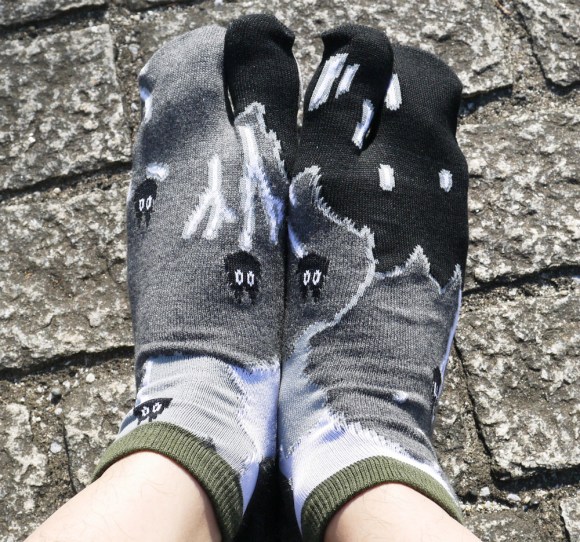
▼The name of the museum and the brand SOU・SOU are printed on the bottom. The socks also come in children’s sizes, so you can give them as presents to families with kids too!
5. Pop-up post card (large size: 432 yen [$3.63], small size: 324 yen [$2.70])
At first glance, these cards look like regular post cards, but they’re actually highly artistic creations that you can build and turn into three-dimensional dioramas. Their intricate designs are based on the exterior and interior of the Ghibli Museum. What a great card to send to a Ghibli fan!
▼Believe it or not, this post card can be turned into a diorama!
▼The back of the card is mostly blank.
▼It even shows where to stick on the stamps so that you can actually mail the card. It’s sure to be a big hit with any friends or family who like Ghibli!
▼It also shows you how to create the pop-up.
▼We get to work building the three-dimensional scene!
▼The details and colors are brilliant!
▼Project completed! It’s a beautiful miniature of the Ghibli Museum!
▼Here’s another card depicting the interior of the museum.
▼Again, the details are amazing!
▼We had a few volunteers try turning the card into a diorama:
▼There’s also a card recreating the famous “Totoro ticket counter” that guests see upon arriving at the museum.
▼And this is what the card looks like in 3D!
▼Why not combine the cards to create your very own Ghibli Museum model? Just looking at it makes you feel like you’re right there at the museum!
6. The baby-size “Boh” T-shirt (3,456 yen [$29.10]/ 90cm [two-year-old] size)
Now, this is something you’ll want to get for anyone with an infant at home. It’s an adorable baby T-shirt with the same design as the bib worn by the “Boh” character in Spirited Away. We’re sure you’ll love the practical design and delightful details on this item!
▼There are buttons on the shoulder so you can dress your baby in it easily.
▼The bib design is faithfully recreated on the back too.
▼A picture of Boh in his transformed mouse form is printed on the arm. Simply too cute!
▼See the attention to detail, even where it’s not visible. Hidden on the inside of the shirt is the abura (油) logo of the Aburaya Bathhouse.
7. Museum Emblem Cookies (1,728 yen [$14.50])
These cookies are not only sweet to taste but a pleasure to look at as well! They’re decorated with the museum emblem and other Ghibli character motifs, and the can they come in is also lovely and can be used to store other things once you’re done with the cookies.
▼Even the side of the lid is covered with delightful Ghibli illustrations!
▼The yummy cookies come in five flavors — chocolate, tea, almond, sesame, and maple — and once you start eating them, you won’t want to stop.
▼They’re almost too pretty to eat, especially the large cookies with the museum logo.
8. Stained glass-style postcards (Large size: 756 yen [$6.40], Small size: 648 yen [$5.50])
These gorgeous postcards show lovely images from much-loved Ghibli movies in stained glass style. Place them near a window and the pictures should catch the light beautifully. Why not collect a set of them and create your own “Ghibli space” at home?
▼The brightly colored postcards come in a variety of designs.
▼Here’s a closer look at the pictures:
▼The best part about these cards is seeing them against the light.
▼You can open the “window” on the back of the card …
▼… and you can see the image in all its splendid colors throughout the day!
9. Ghibli chopsticks (2,592 yen [$21.81])
Like the tabi-shita socks, this is also an item with a Japanese taste which may make for a nice souvenir for visitors from abroad. The chopsticks are finished in Japanese lacquer, which should add to their appeal, and come with accessories including a small Totoro charm and a cloth carrying pouch.
▼The traditional lacquer finish gives the chopsticks an authentic Japanese look, making them an ideal gift to take home from Japan.
▼This is the miniature wood Totoro charm that comes with the chopsticks. We think Totoro looks elegant yet adorable here!
▼Again, there are some delightful touches added — see the black soot spirits known as “Makkuro Kurosuke” delicately carved into the sticks!
▼You can place the chopsticks in the pouch …
▼ That way, you can carry your chopsticks with you in a tidy package.
10. Paper Craft Letter Card (410 yen [$3.45])
Of all the items we saw at the museum shop, we have to say, this is the item that impressed us the most. Yes, the pop-up postcards we showed earlier were amazing too, but this topped it all, because this letter card actually allows you to create a piece of animation in 3D!
If you’re a Ghibli fan who’s visited or done some research into the museum, you’ll probably know that one of the notable attractions there is the moving three-dimensional “Bouncing Totoro (Totoro Pyon Pyon)” Zoetrope. Well, this letter card is a recreation of that zoetrope. It’s quite reasonably priced too, at 410 yen, so if you visit the museum, we highly recommend you purchase one of theses and try making the replica of the museum’s zoetrope.
▼The Paper Craft Letter Card which we were thoroughly impressed with!
▼You can actually send it by post too!
▼The card includes all the parts you need to make the miniature zoetrope.
▼All you have to do is cut all the pieces out and assemble them into the right shape.
▼This is what the completed paper craft zoetrope looks like.
▼You can turn the stick-like piece in the middle to move the characters.
▼See the figures come to life in this video of the Paper Craft Letter Card we actually built!
We hope you enjoyed our selection of must-buy items from the Ghibli Museum shop. We think they’re fun, original (and in some cases quite hands-on) products befitting a creative outlet such as Ghibli. If you plan on visiting the museum in the future, we hope our suggestions may be of some help when you’re shopping there. Or, if you’ve already been to the museum and have some favorite gift shop items of your own, we’d love to hear about them as well! And most of all, we wish anyone visiting the museum a truly magical time – we wouldn’t expect anything less from Ghibli, would we?
Related: Ghibli Museum website
Photos © RocketNews24
Original article by: Daiichiro Tashiro



















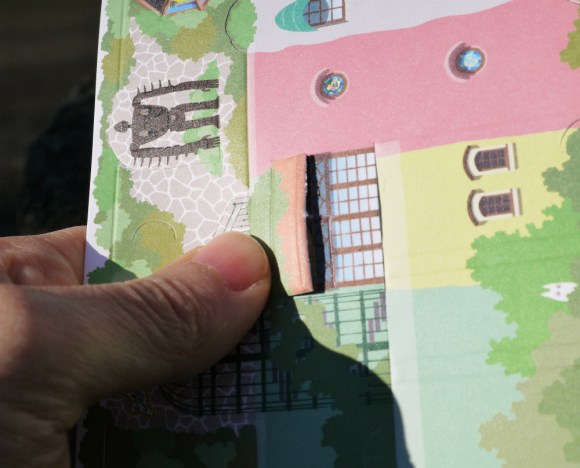



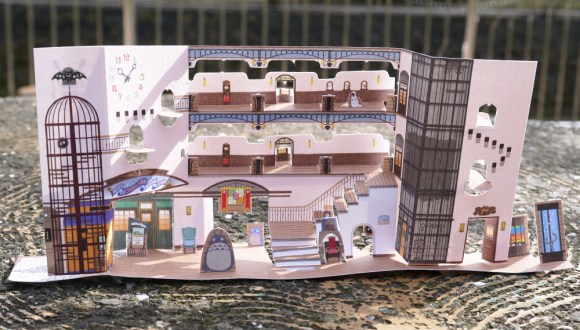





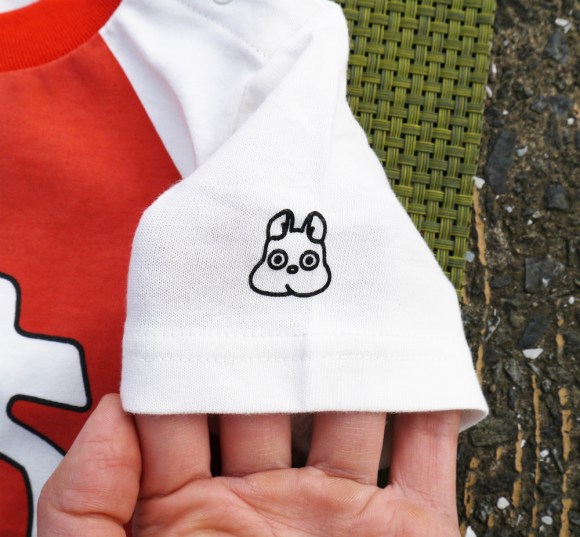

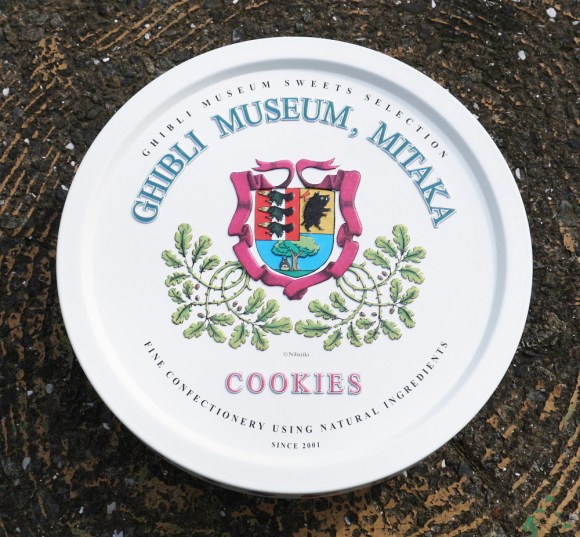






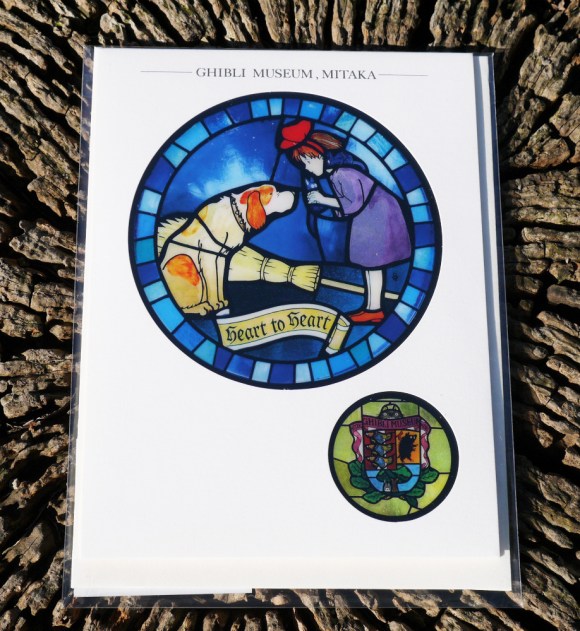


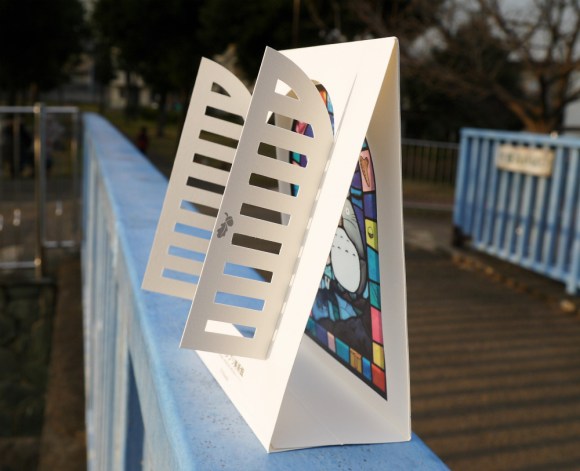
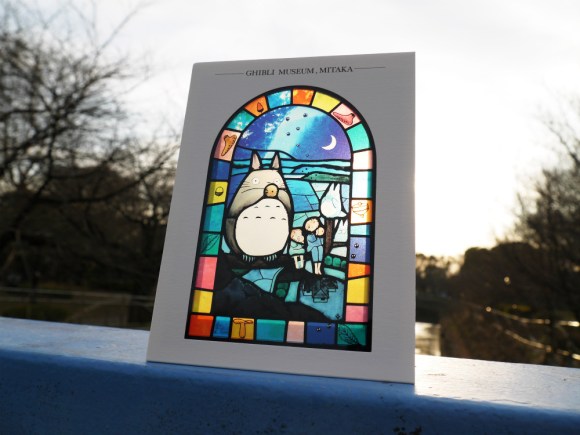

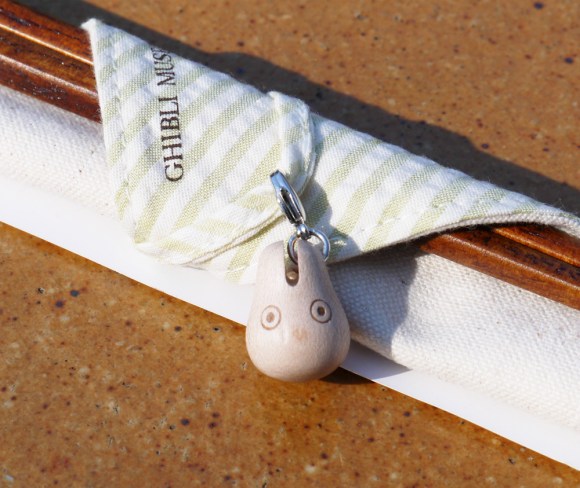


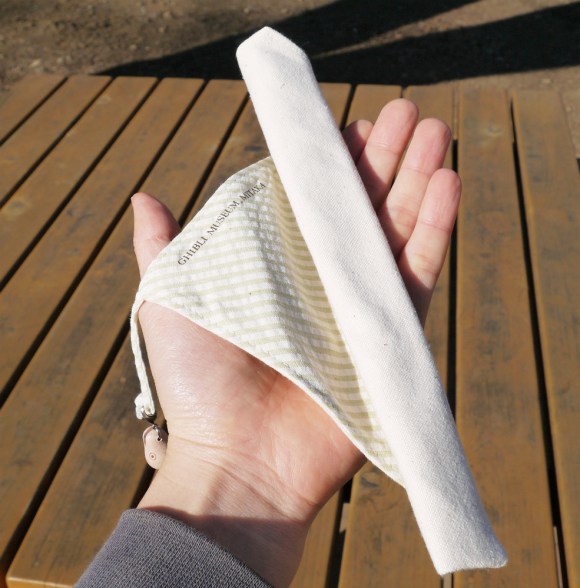







 Studio Ghibli releases fluffy My Neighbour Totoro T-shirts that’ll have you touching your chest all day long
Studio Ghibli releases fluffy My Neighbour Totoro T-shirts that’ll have you touching your chest all day long Studio Ghibli releases card holders that look like the Ghibli Museum
Studio Ghibli releases card holders that look like the Ghibli Museum Ghibli Museum opens online store!
Ghibli Museum opens online store! Studio Ghibli’s “Bouncing Totoro” zoetrope gets its own merchandise at museum
Studio Ghibli’s “Bouncing Totoro” zoetrope gets its own merchandise at museum Ghibli Museum store shares the task all new employees struggle with, and how to overcome it【Vid】
Ghibli Museum store shares the task all new employees struggle with, and how to overcome it【Vid】 Our 52-year-old pole dancing reporter shares his tips for achieving your New Year’s exercise goal
Our 52-year-old pole dancing reporter shares his tips for achieving your New Year’s exercise goal Ramen restaurant’s English menu prices are nearly double its Japanese ones, denies discriminating
Ramen restaurant’s English menu prices are nearly double its Japanese ones, denies discriminating Umamusume anime girl plushie recalled for having parts she absolutely should not have【Pics】
Umamusume anime girl plushie recalled for having parts she absolutely should not have【Pics】 How lucky are the themed retro video game lucky bags from this shop in the Tokyo boonies?
How lucky are the themed retro video game lucky bags from this shop in the Tokyo boonies? Starbucks Japan releases new Frappuccino and latte for Valentine’s Day
Starbucks Japan releases new Frappuccino and latte for Valentine’s Day 10 times to avoid traveling in Japan in 2026
10 times to avoid traveling in Japan in 2026 New Japanese menstrual product seeks to help women spot unidentified iron deficiencies
New Japanese menstrual product seeks to help women spot unidentified iron deficiencies Survey says osechi New Year’s food differs according to each region in Japan
Survey says osechi New Year’s food differs according to each region in Japan Does this video about an abandoned dog leave you wiping your eyes or shaking your fist?
Does this video about an abandoned dog leave you wiping your eyes or shaking your fist? Say hello to Japan’s new stationmaster cat!【Video】
Say hello to Japan’s new stationmaster cat!【Video】 Japanese beef bowl chain Sukiya’s 2026 Smile Box lucky bag basically pays for itself
Japanese beef bowl chain Sukiya’s 2026 Smile Box lucky bag basically pays for itself Top Japanese cosplayer Enako returns to Comiket after 6 years, creates mayhem with admirers
Top Japanese cosplayer Enako returns to Comiket after 6 years, creates mayhem with admirers Cup Noodle tries an authentic Jiro-style ramen, but something’s not quite right
Cup Noodle tries an authentic Jiro-style ramen, but something’s not quite right Hayao Miyazaki says Happy New Year to Studio Ghibli fans with new art for Year of the Horse
Hayao Miyazaki says Happy New Year to Studio Ghibli fans with new art for Year of the Horse Starbucks Japan ready to get Year of the Horse started with adorable drinkware and plushies【Pics】
Starbucks Japan ready to get Year of the Horse started with adorable drinkware and plushies【Pics】 We ate sushi made from Japan’s most expensive tuna ever【Taste test】
We ate sushi made from Japan’s most expensive tuna ever【Taste test】 7-Eleven Japan starts new temporary luggage storage service in over 300 branches
7-Eleven Japan starts new temporary luggage storage service in over 300 branches Disillusionment at Tsukiji’s tourist-target prices led us to a great ramen restaurant in Tokyo
Disillusionment at Tsukiji’s tourist-target prices led us to a great ramen restaurant in Tokyo Starbucks teams up with 166-year-old Kyoto doll maker for Year of the Horse decorations【Photos】
Starbucks teams up with 166-year-old Kyoto doll maker for Year of the Horse decorations【Photos】 Tokyo’s Tsukiji sushi neighborhood asks tour groups to stay away for the rest of the month
Tokyo’s Tsukiji sushi neighborhood asks tour groups to stay away for the rest of the month Japan may add Japanese language proficiency, lifestyle classes to permanent foreign resident requirements
Japan may add Japanese language proficiency, lifestyle classes to permanent foreign resident requirements Lacquerware supplier to emperor of Japan and Pokémon team up for new tableware
Lacquerware supplier to emperor of Japan and Pokémon team up for new tableware Starbucks Japan releases new zodiac chilled cup drink for 2026
Starbucks Japan releases new zodiac chilled cup drink for 2026 Tokyo considering law requiring more trash cans following litter increase in heavily touristed area
Tokyo considering law requiring more trash cans following litter increase in heavily touristed area Survey asks foreign tourists what bothered them in Japan, more than half gave same answer
Survey asks foreign tourists what bothered them in Japan, more than half gave same answer Japan’s human washing machines will go on sale to general public, demos to be held in Tokyo
Japan’s human washing machines will go on sale to general public, demos to be held in Tokyo We deeply regret going into this tunnel on our walk in the mountains of Japan
We deeply regret going into this tunnel on our walk in the mountains of Japan Studio Ghibli releases Kodama forest spirits from Princess Mononoke to light up your home
Studio Ghibli releases Kodama forest spirits from Princess Mononoke to light up your home Major Japanese hotel chain says reservations via overseas booking sites may not be valid
Major Japanese hotel chain says reservations via overseas booking sites may not be valid Put sesame oil in your coffee? Japanese maker says it’s the best way to start your day【Taste test】
Put sesame oil in your coffee? Japanese maker says it’s the best way to start your day【Taste test】 No more using real katana for tourism activities, Japan’s National Police Agency says
No more using real katana for tourism activities, Japan’s National Police Agency says Starbucks Japan reveals new sakura drinkware collection, inspired by evening cherry blossoms
Starbucks Japan reveals new sakura drinkware collection, inspired by evening cherry blossoms Updated cherry blossom forecast shows extra-long sakura season for Japan this year
Updated cherry blossom forecast shows extra-long sakura season for Japan this year Human washing machine pods coming to Japanese hotels【Photos】
Human washing machine pods coming to Japanese hotels【Photos】 All aboard the Catbus at Ghibli Museum’s 15th Anniversary Celebration!
All aboard the Catbus at Ghibli Museum’s 15th Anniversary Celebration! Secretive Ghibli Museum starts video diary to give glimpse inside anime attraction【Videos】
Secretive Ghibli Museum starts video diary to give glimpse inside anime attraction【Videos】 Tokyo’s Ghibli Museum set to crack down on ticket scalping and resales with pre-entry ID checks
Tokyo’s Ghibli Museum set to crack down on ticket scalping and resales with pre-entry ID checks Ghibli Museum virtual tour reveals what’s inside the female toilets【Video】
Ghibli Museum virtual tour reveals what’s inside the female toilets【Video】 Ghibli Museum clock is now yours to take home with you
Ghibli Museum clock is now yours to take home with you Hayao Miyazaki’s concept art and ideas for the Ghibli Museum to be revealed in new exhibit
Hayao Miyazaki’s concept art and ideas for the Ghibli Museum to be revealed in new exhibit Ghibli Museum asking for donations to help pay for operating costs and repairs
Ghibli Museum asking for donations to help pay for operating costs and repairs Ghibli Museum re-opening, tickets on sale in a few days
Ghibli Museum re-opening, tickets on sale in a few days Ghibli Museum asking for donations from overseas fans to help it through hard times
Ghibli Museum asking for donations from overseas fans to help it through hard times Tokyo’s Ghibli museum to reopen this month, but only for one group of people
Tokyo’s Ghibli museum to reopen this month, but only for one group of people Special exhibits on Studio Ghibli’s art and architecture coming soon to two Tokyo museums
Special exhibits on Studio Ghibli’s art and architecture coming soon to two Tokyo museums Ghibli Museum Attracts 10 Million Visitors
Ghibli Museum Attracts 10 Million Visitors Ghibli Museum now lets you bring features of the building home with you…in cute miniature form
Ghibli Museum now lets you bring features of the building home with you…in cute miniature form Ghibli Museum merchandise from Boro The Caterpillar short anime movie now on sale!
Ghibli Museum merchandise from Boro The Caterpillar short anime movie now on sale! Ghibli Museum video takes us into the steam punk elevator and up the spiral staircase【Video】
Ghibli Museum video takes us into the steam punk elevator and up the spiral staircase【Video】
Leave a Reply